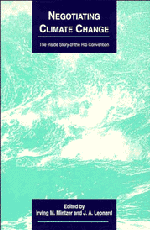Book contents
- Frontmatter
- Contents
- Acknowledgements
- Commonly Used Acronyms
- Foreword
- Part I Background
- Part II Views from Within the Ring
- 3 Exercising Common but Differentiated Responsibility
- 4 The Beginnings of an International Climate Law
- 5 Constructive Damage to the Status Quo
- 6 The Climate Change Negotiations
- 7 A Personal Assessment
- 8 The Road to Rio
- 9 A Failure of Presidential Leadership
- 10 Looking Back to See Forward
- Part III The Outside Edges In
- Part IV Prospects for the Future
- Appendix: The Framework Convention on Climate Change
- Index
7 - A Personal Assessment
Published online by Cambridge University Press: 01 June 2011
- Frontmatter
- Contents
- Acknowledgements
- Commonly Used Acronyms
- Foreword
- Part I Background
- Part II Views from Within the Ring
- 3 Exercising Common but Differentiated Responsibility
- 4 The Beginnings of an International Climate Law
- 5 Constructive Damage to the Status Quo
- 6 The Climate Change Negotiations
- 7 A Personal Assessment
- 8 The Road to Rio
- 9 A Failure of Presidential Leadership
- 10 Looking Back to See Forward
- Part III The Outside Edges In
- Part IV Prospects for the Future
- Appendix: The Framework Convention on Climate Change
- Index
Summary
Prologue
An unusually heterogenous group met in the new Westfields Conference Center at Chantilly, VA, outside Washington, DC, in February 1991. There were diplomats and climate experts, people from capitals and permanent UN delegations, old hands at multilateral negotiation as well as newcomers. They came from almost a hundred different countries, with divergent objectives and negotiating goals. And there was considerable uncertainty in the air.
Nonetheless, in the late afternoon of May 9, 1992, just fifteen months Later—as Chairman Jean Ripert of France concluded the negotiation and received well-deserved applause—many of the negotiators had become friends and would regret the unavoidable separation. Group dynamics had worked wonders throughout the many negotiating sessions and late-night drafting meetings. It was a special human experience and an example of what multilateral negotiation can achieve, if the conditions are right.
One reason for our success was the structure of the negotiations: they took place within the general framework of preparations for the UN Conference on Environment and Development (UNCED), sometimes called the Earth Summit, working under an implied pressure to produce a Convention before the Rio Conference in June 1992. With that sense of urgency came an overriding concern for the global environment and the conviction that important issues, critical to the future of mankind, were at stake. Without pressing the argument too far, even the most experienced or cynical negotiators had to be sensitive to this kind of reasoning.
- Type
- Chapter
- Information
- Negotiating Climate ChangeThe Inside Story of the Rio Convention, pp. 149 - 174Publisher: Cambridge University PressPrint publication year: 1994
- 5
- Cited by



